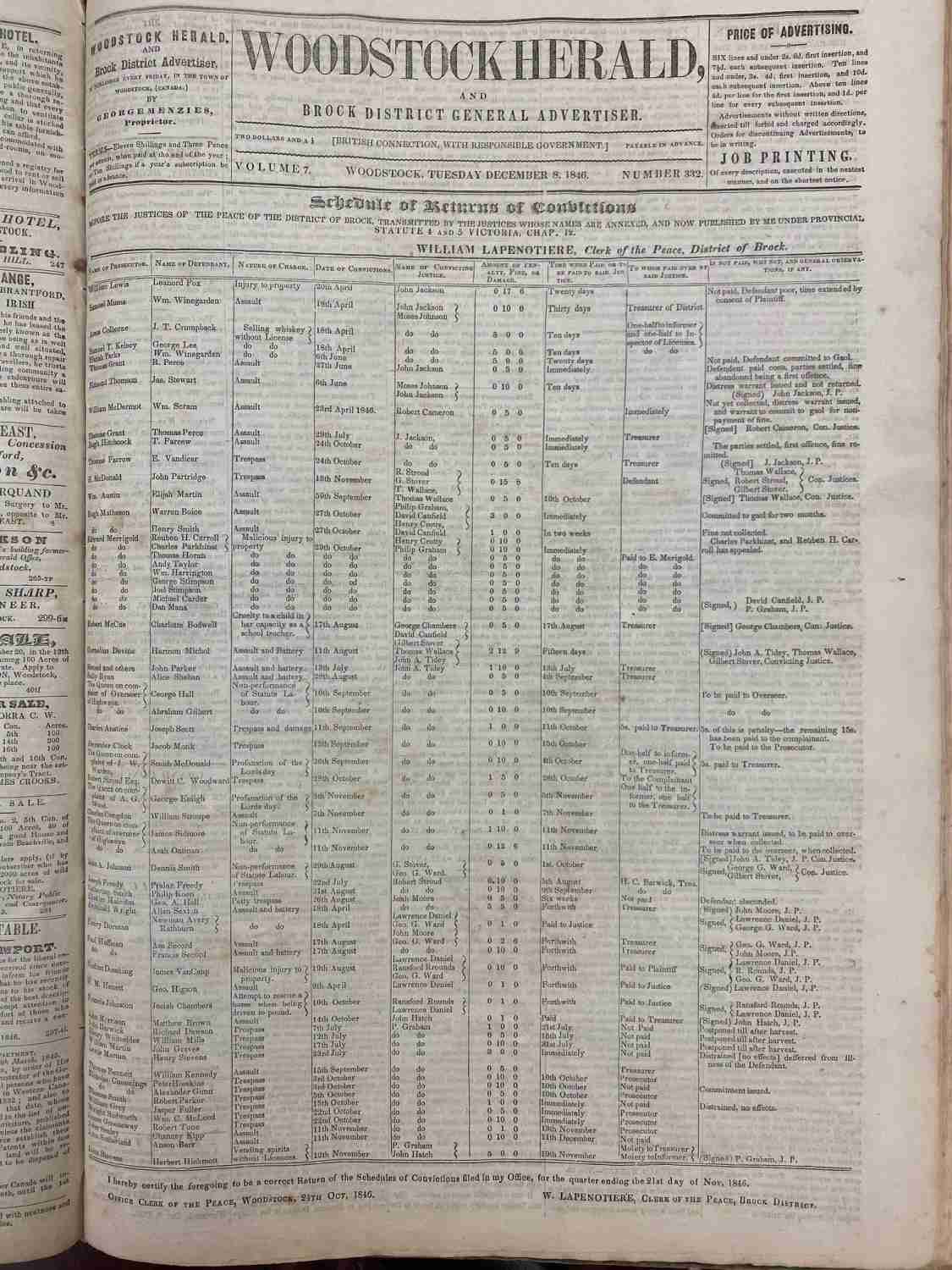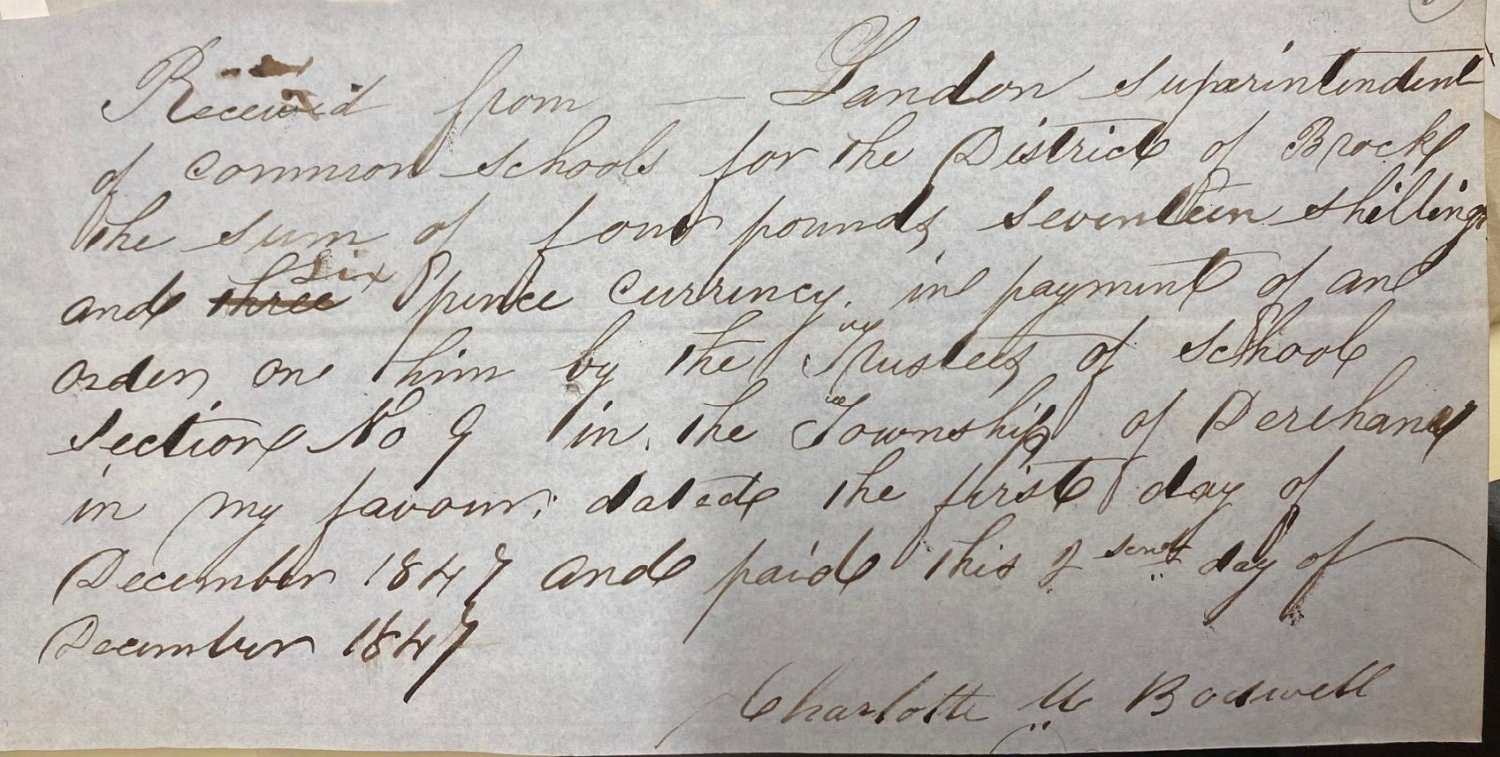1800s Corporal Punishment in Rural Schools
1800s Corporal Punishment in Rural Schools
This week, our archivist delves into the history of corporal punishment in rural schools.
By Liz Dommasch, Archivist
We recently received a transfer of bound newspapers from the Toronto Reference Library which included early editions of the Oxford Star & Woodstock Advertiser (1848-1849) and Woodstock Herald & Brock District General Advertiser (1846-1847). The early newspapers provide an interesting insight into the history of the District of Brock (predecessor to Oxford County) and the international headlines worth printing at the time. Similar to the Woodstock Sentinel-Review newspapers that would print information on crimes and those that committed them, the early newspapers would do the same. On December 8, 1846, the Woodstock Herald printed a Schedule of Return of Convictions as certified by W. Lapenotiere, Clerk of the Peace for the quarter ending the previous month. Along with the typical convictions of trespassing and assault, there was one conviction that stood out. On August 17, 1846, a woman by the name of Charlotte Bodwell was charged by Robert McCue with cruelty to a child (in this case, his) in her capacity as a school teacher for which she received a fine.

A Schedule of Return of Convictions printed in the "Woodstock Herald" newspaper, 8 December 1846. [COA175 Woodstock Herald and Oxford Star fonds]
Searching through the newspaper further and the District of Brock records at the Archives there is no further mention of the incident, though it is interesting to imagine what occurred. Punishment in schools was quite common during the 19th Century as it was believed to help restore order, discipline the body and motivate the mind and could be inflicted on a student for a variety of reasons, such as misbehaving, rudeness, laziness, lying, and missing school without a good reason.
One of the most popular tools used for punishment was a cane made of birch wood. Boys were typically caned on their backsides whereas girls would be caned on their legs or hands. Although the teacher would usually dole out such a punishment, he or she would sometimes select an older student to cane a younger one. The theological doctrine of the time of “spare the rod” offered a power validation for such physical discipline not only at school but at home as well.
Another popular form of punishment was that of the dunce cap. Usually made of newspaper, a student would be forced to sit in a corner of the classroom, wearing the so-called cap for a period of time deemed by the teacher. The dunce cap was used mostly to humiliate "class clowns", slow learners, or any other child causing a ruckus or not paying attention and would continue to be used as a form of discipline well into the 21st century. Other forms of punishment used at the time included assigning a student “lines” to write on the chalkboard or forcing a student to write with their right hand instead of their left if they were left-handed.

Illustration from a children’s book showing a “dunce” wearing a fool’s cap with a bell and donkey ears. "Nursery Novelties for Little Masters and Misses", 1820
Although we do not know what crime Charlotte committed, we know from the records we do have that she taught in Dereham Township in School District No. 13 and was considered a duly qualified teacher according to the report made by the Trustees for 1846. Whatever occurred did not warrant her dismissal and, in fact, she continued to be employed by the School District until her wedding in 1848.
![A School Trustees Report including names of parents and how many children they have. Names include: Wesley Stover, Roswell Rement, William Atwood, Dered[?] [Prich?], Robert Meue, James Mitchel, Lewes Jacques, John Gregg, George Mahood. A School Trustees Report including names of parents and how many children they have. Names include: Wesley Stover, Roswell Rement, William Atwood, Dered[?] [Prich?], Robert Meue, James Mitchel, Lewes Jacques, John Gregg, George Mahood.](/images/blog/Trustees%20report%20including%20names%20of%20parents%20-%201%20January%201847.jpg)
School Trustees Report including the names of parents and the number of children they have, 1 January 1847
At the time, Charlotte taught 29 students (33 children in total in the district), in a one-room schoolhouse, ranging in age from five to sixteen years. Many were siblings and came from well-known local families. Charlotte would have been required to not only organize lessons in reading, writing, arithmetic, spelling, and geography for a variety of ages and abilities; but would have been responsible for cleaning the building and ensuring the wood stove remained lit, amongst other duties. It’s also possible that Charlotte hadn’t received professional teacher training (Normal Schools for training teachers did not open until the late 1840s and early 1850s in large urban centres) and would have relied on a combination of high school work and a couple of months of basic training to prepare her for life in the classroom.
Charlotte Matilda Bodwell was born in Mt. Elgin in 1825 to James Bodwell Jr. and Abigail (nee) Vining. One of ten children, Charlotte, as well as her younger brother Ebenezer, were employed for some time as teachers in Dereham Township. In 1848, she married Wright Barker and moved to a farm outside Tillsonburg. She would pass away in Tillsonburg on January 25, 1906.

A receipt for the salary payment of Charlotte Bodwell, December 1847.
